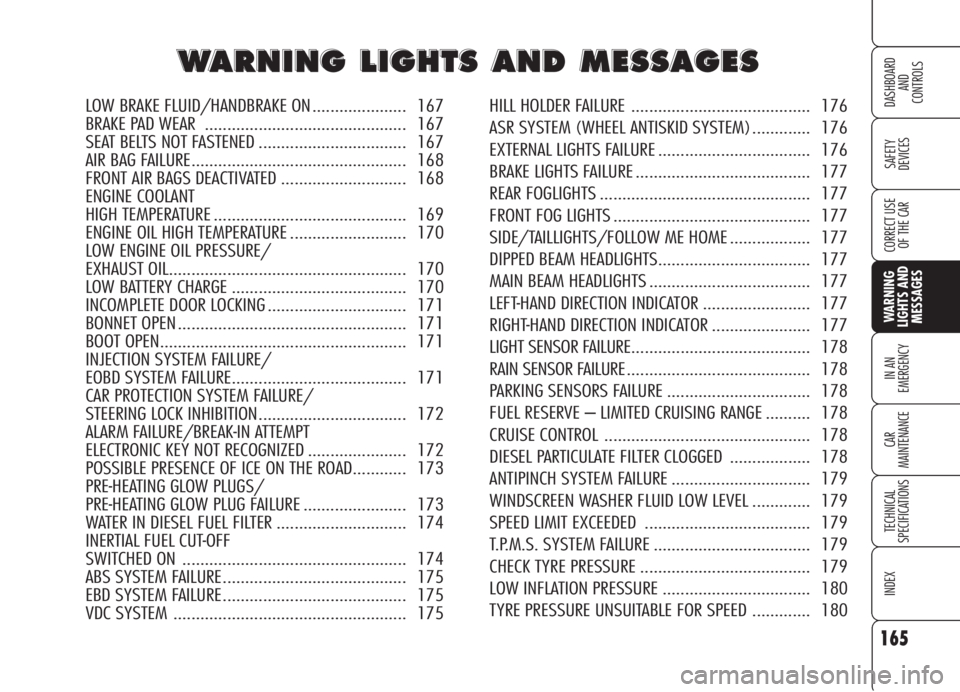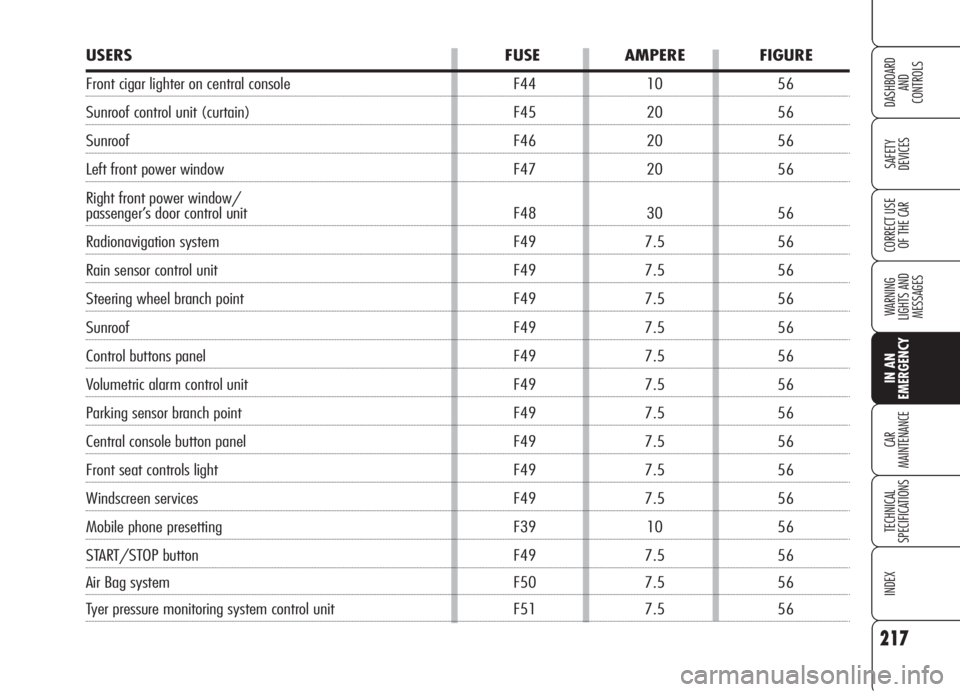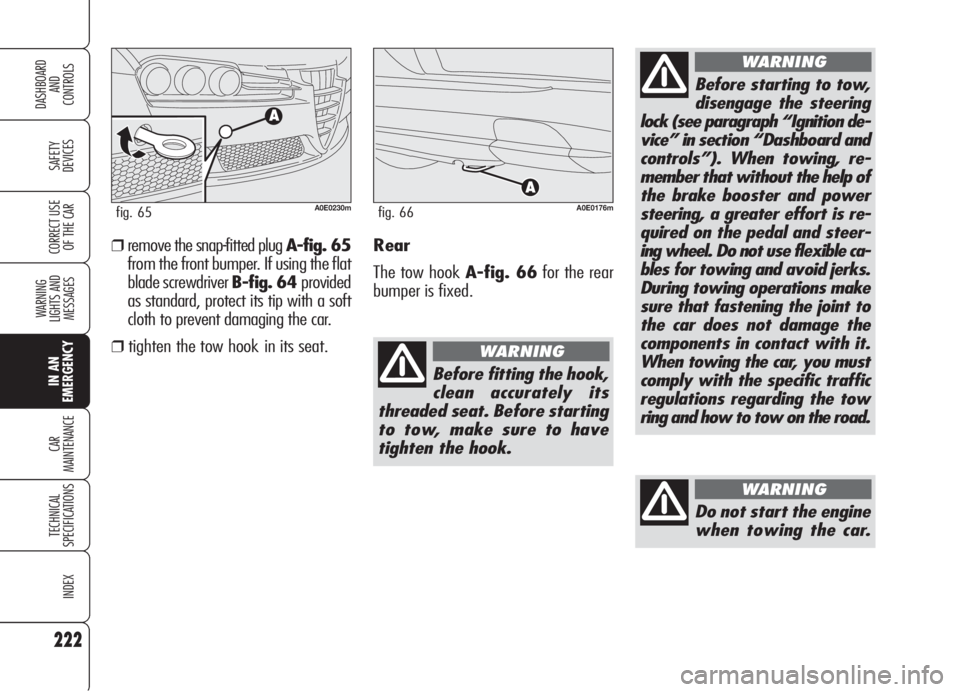steering wheel Alfa Romeo 159 2006 Owner handbook (in English)
[x] Cancel search | Manufacturer: ALFA ROMEO, Model Year: 2006, Model line: 159, Model: Alfa Romeo 159 2006Pages: 299, PDF Size: 4.64 MB
Page 144 of 299

142
WARNING
LIGHTS AND
MESSAGES
IN AN
EMERGENCY
CAR
MAINTENANCE
TECHNICAL
SPECIFICATIONS
INDEX
CORRECT USE
OF THE CAR
DASHBOARD
AND
CONTROLS
SAFETY
DEVICES
FRONT AIR BAGS
The car is fitted with front multistage air
bags (“Smart bags”) for the driver and
the passenger and with knees air bag
for the driver and for the passenger
(where provided).The front air bags (driver and passen-
ger) and knees air bags (driver and pas-
senger) are not a replacement of but
complementary to the use of belts,
which should always be worn, as spec-
ified by law in Europe and most non Eu-
ropean countries.
In case of crash, a person not wearing
the seat belt moves forward and may
come into contact with the cushion while
it is still inflating. Under this circum-
stance the protection offered by the air
bag is reduced.
“SMART BAG” SYSTEM
(FRONT MULTISTAGE AIR
BAGS)
The front air bags (driver and passen-
ger) and knees air bags (driver and pas-
senger) have been designed to protect
the occupants in the event of head-on
crashes of medium-high severity, by plac-
ing cushions between the occupant and
the steering wheel or dashboard.
In case of crash, an electronic control
unit, when required, triggers the infla-
tion of the cushions that inflate, as a pro-
tection, between the body of the front
occupants and the structure that could
cause injuries. Immediately after, the
cushions deflate.
Page 145 of 299

143
WARNING
LIGHTS AND
MESSAGES
IN AN
EMERGENCY
CAR
MAINTENANCE
TECHNICAL
SPECIFICATIONS
INDEX
CORRECT USE
OF THE CAR
DASHBOARD
AND
CONTROLS
SAFETY
DEVICES
DRIVER’S FRONT AIR BAG
It consists of an instant-inflating cushion
contained in a special recess in the cen-
tre of the steering wheelfig. 14. Front air bags may not be activated in
the following situations:
❒front collisions against highly de-
formable objects not affecting the car
front surface (e.g. bumper collision
against guard rail, etc.);
❒in case of wedging under other ve-
hicles or protective barriers (for ex-
ample under a truck or guard rail);
❒the air bag is not triggered as it offers
no additional protection compared with
the seat belts, consequently it would
be pointless. Therefore, failure to come
into action in the above circumstance
does not mean that the system is not
working properly.
Do not apply stickers
or other objects to the
steering wheel or to the air
bag cover on the passenger’s
side or on the side roof lining.
Never put objects (e.g. mobile
phones) on the dashboard on
passenger side since they
could interfere with proper
passenger air bag inflation and
also cause serious injury.
WARNING
A0E0077mfig. 14
Page 147 of 299

145
WARNING
LIGHTS AND
MESSAGES
IN AN
EMERGENCY
CAR
MAINTENANCE
TECHNICAL
SPECIFICATIONS
INDEX
CORRECT USE
OF THE CAR
DASHBOARD
AND
CONTROLS
SAFETY
DEVICES
MANUAL DEACTIVATION (where provided) OF PASSENGER’S
FRONT AIR BAG , KNEES AIR BAG (where provided) AND
PASSENGER’S FRONT SIDE BAG DRIVER’S AND
PASSENGER’S KNEES AIR
BAG (where provided)
Knees air bag consists of an instant-in-
flating cushion housed into a special
compartment provided for the purpose
under the steering wheel for the driver
fig. 16and into the lower part of the
dashboard for the passenger fig. 17,
to give further protection in the event of
frontal crash.
A0E0092mfig. 17A0E0079mfig. 16
Should it be absolutely necessary to car-
ry a child on the front seat, the pas-
senger’s front air bag, knees air bag
(where provided) and the side bag can
be deactivated. Deactivation/activation
shall be performed (with key removed
from ignition device) using the key
switch set on the right side of dashboard
fig. 18. You can reach the switch on-
ly if the door is opened. When the door
is open, the metal insert of the key can
be inserted and removed in both posi-
tions.IMPORTANTOperate the switch on-
ly when the engine is not running and
the ignition key is removed.
The key-operated switch has two posi-
tions:
❒passenger's front air bag and knees
air bag (where provided) and side
bag activated (ONposition
P):
warning light
Fon front ceiling light
panel off; it is absolutely prohibited
to carry a child on the front seat;
A0E0062mfig. 18
Page 151 of 299

149
WARNING
LIGHTS AND
MESSAGES
IN AN
EMERGENCY
CAR
MAINTENANCE
TECHNICAL
SPECIFICATIONS
INDEX
CORRECT USE
OF THE CAR
DASHBOARD
AND
CONTROLS
SAFETY
DEVICES
GENERAL WARNINGS
If when fitting the key
into the ignition device,
the warning light
¬does not
turn on or if it stays on when
travelling (on certain versions
together with the message on
the display) there could be a
failure in safety systems; in
this event air bags or preten-
sioners could not trigger in
case of impact or, in a minor
number of cases, they could
trigger accidentally. Contact
Alfa Romeo Authorized Ser-
vices immediately to have the
system checked.
WARNING
Do not cover the back-
rest of front seats with
trims or covers that are not
suitable to be used with side
bags.
WARNING
Never travel with ob-
jects on your lap, in
front of your chest or with a
pipe, pencil, etc. between your
lips; injury may result in the
event of the air bag being trig-
gered.
WARNING
Always keep your
hands on the steering
wheel rim when driving, so
that if the air bag is triggered,
it can inflate without meeting
any obstacles which could
cause serious harm to you. Do
not drive with the body bent
forwards, keep the seat back
rest in the erect position and
lean your back well against it.
WARNING
If the car has been
stolen or an attempt to
steal it has been made, if it
has been subjected to vandals
or floods, have the air bag
system checked by Alfa Romeo
Authorized Services.
WARNING
Remember that with
the key fitted into the
ignition device and engine off,
the air bags may be triggered
on a stationary car if it is
bumped by another moving
car. Therefore, never seat chil-
dren on the front seat even
when the car is stationary. On
the other hand remember that
if the key is not fitted into the
ignition device, no safety sys-
tem (air bags or pretension-
ers) is triggered in the event
of an impact; in this case, fail-
ure to come into action cannot
be considered as a sign that
the system is not working
properly.
WARNING
Page 167 of 299

165
SAFETY
DEVICES
IN AN
EMERGENCY
CAR
MAINTENANCE
TECHNICAL
SPECIFICATIONS
INDEX
CORRECT USE
OF THE CAR
DASHBOARD
AND
CONTROLS
WARNING
LIGHTS AND
MESSAGES
W W
A A
R R
N N
I I
N N
G G
L L
I I
G G
H H
T T
S S
A A
N N
D D
M M
E E
S S
S S
A A
G G
E E
S S
LOW BRAKE FLUID/HANDBRAKE ON ..................... 167
BRAKE PAD WEAR ............................................. 167
SEAT BELTS NOT FASTENED ................................. 167
AIR BAG FAILURE................................................ 168
FRONT AIR BAGS DEACTIVATED ............................ 168
ENGINE COOLANT
HIGH TEMPERATURE ........................................... 169
ENGINE OIL HIGH TEMPERATURE .......................... 170
LOW ENGINE OIL PRESSURE/
EXHAUST OIL..................................................... 170
LOW BATTERY CHARGE ....................................... 170
INCOMPLETE DOOR LOCKING ............................... 171
BONNET OPEN ................................................... 171
BOOT OPEN....................................................... 171
INJECTION SYSTEM FAILURE/
EOBD SYSTEM FAILURE....................................... 171
CAR PROTECTION SYSTEM FAILURE/
STEERING LOCK INHIBITION................................. 172
ALARM FAILURE/BREAK-IN ATTEMPT
ELECTRONIC KEY NOT RECOGNIZED ...................... 172
POSSIBLE PRESENCE OF ICE ON THE ROAD............ 173
PRE-HEATING GLOW PLUGS/
PRE-HEATING GLOW PLUG FAILURE ....................... 173
WATER IN DIESEL FUEL FILTER ............................. 174
INERTIAL FUEL CUT-OFF
SWITCHED ON .................................................. 174
ABS SYSTEM FAILURE......................................... 175
EBD SYSTEM FAILURE......................................... 175
VDC SYSTEM .................................................... 175HILL HOLDER FAILURE ........................................ 176
ASR SYSTEM (WHEEL ANTISKID SYSTEM) ............. 176
EXTERNAL LIGHTS FAILURE .................................. 176
BRAKE LIGHTS FAILURE ....................................... 177
REAR FOGLIGHTS ............................................... 177
FRONT FOG LIGHTS ............................................ 177
SIDE/TAILLIGHTS/FOLLOW ME HOME .................. 177
DIPPED BEAM HEADLIGHTS.................................. 177
MAIN BEAM HEADLIGHTS .................................... 177
LEFT-HAND DIRECTION INDICATOR ........................ 177
RIGHT-HAND DIRECTION INDICATOR ...................... 177
LIGHT SENSOR FAILURE........................................ 178
RAIN SENSOR FAILURE......................................... 178
PARKING SENSORS FAILURE ................................ 178
FUEL RESERVE – LIMITED CRUISING RANGE .......... 178
CRUISE CONTROL .............................................. 178
DIESEL PARTICULATE FILTER CLOGGED .................. 178
ANTIPINCH SYSTEM FAILURE ............................... 179
WINDSCREEN WASHER FLUID LOW LEVEL ............. 179
SPEED LIMIT EXCEEDED ..................................... 179
T.P.M.S. SYSTEM FAILURE ................................... 179
CHECK TYRE PRESSURE ...................................... 179
LOW INFLATION PRESSURE ................................. 180
TYRE PRESSURE UNSUITABLE FOR SPEED ............. 180
Page 185 of 299

183
SAFETY
DEVICES
WARNING
LIGHTS AND
MESSAGES
CAR
MAINTENANCE
TECHNICAL
SPECIFICATIONS
INDEX
CORRECT USE
OF THE CAR
DASHBOARD
AND
CONTROLS
IN AN
EMERGENCY
IF A TYRE
IS PUNCTURED
For versions/markets where applicable,
the car can be equipped with the “Quick
tyre repair kit Fix&Go automatic“. Op-
erations required to change a wheel are
described in the following chapter.
As an alternative to the kit “Fix & Go
automatic”, the car can be provided (up-
on request) with space-saver spare
wheel or standard size spare wheel;
wheel changing and correct use of the
jack and space-saver spare wheel call for
some precautions as listed below.
BUMP STARTING
Never bump start the engine (by push-
ing, towing, or coasting downhill) as this
could cause fuel to flow into the catalytic
exhaust system and damage it beyond
repair.
Remember that the
brake booster and the
power steering system are not
operating until the engine is
started, a greater effort will
therefore be required to press
the brake pedal or turn the
steering wheel.
WARNING
Alert other drivers that
the car is stationary in
compliance with local regula-
tions: hazard warning lights,
warning triangle etc. Any pas-
sengers on board should leave
the car, especially if it is heav-
ily laden. Passengers should
stay away from oncoming
traffic while the wheel is be-
ing changed on. If the wheel is
being changed on a steep or
badly surfaced road, place the
wedges or other suitable ma-
terial under the wheel to stop
the car. Never start the engine
when the car is jacked up. If
you were towing a trailer, un-
couple the trailer before jack-
ing the car.
WARNING
Page 219 of 299

217
SAFETY
DEVICES
WARNING
LIGHTS AND
MESSAGES
CAR
MAINTENANCE
TECHNICAL
SPECIFICATIONS
INDEX
CORRECT USE
OF THE CAR
DASHBOARD
AND
CONTROLS
IN AN
EMERGENCY
USERS FUSE AMPERE FIGURE
Front cigar lighter on central console F44 10 56
Sunroof control unit (curtain) F45 20 56
Sunroof F46 20 56
Left front power window F47 20 56
Right front power window/
passenger’s door control unit F48 30 56
Radionavigation system F49 7.5 56
Rain sensor control unit F49 7.5 56
Steering wheel branch point F49 7.5 56
Sunroof F49 7.5 56
Control buttons panel F49 7.5 56
Volumetric alarm control unit F49 7.5 56
Parking sensor branch point F49 7.5 56
Central console button panel F49 7.5 56
Front seat controls light F49 7.5 56
Windscreen services F49 7.5 56
Mobile phone presetting F39 10 56
START/STOP button F49 7.5 56
Air Bag system F50 7.5 56
Tyer pressure monitoring system control unit F51 7.5 56
Page 224 of 299

222
SAFETY
DEVICES
WARNING
LIGHTS AND
MESSAGES
CAR
MAINTENANCE
TECHNICAL
SPECIFICATIONS
INDEX
CORRECT USE
OF THE CAR
DASHBOARD
AND
CONTROLS
IN AN
EMERGENCY
Do not start the engine
when towing the car.
WARNING
Before fitting the hook,
clean accurately its
threaded seat. Before starting
to tow, make sure to have
tighten the hook.
WARNING
Before starting to tow,
disengage the steering
lock (see paragraph “Ignition de-
vice” in section “Dashboard and
controls”). When towing, re-
member that without the help of
the brake booster and power
steering, a greater effort is re-
quired on the pedal and steer-
ing wheel. Do not use flexible ca-
bles for towing and avoid jerks.
During towing operations make
sure that fastening the joint to
the car does not damage the
components in contact with it.
When towing the car, you must
comply with the specific traffic
regulations regarding the tow
ring and how to tow on the road.
WARNING
Rear
The tow hook A-fig. 66for the rear
bumper is fixed.
A0E0176mfig. 66
❒remove the snap-fitted plug A-fig. 65
from the front bumper. If using the flat
blade screwdriver B-fig. 64 provided
as standard, protect its tip with a soft
cloth to prevent damaging the car.
❒tighten the tow hook in its seat.
A0E0230mfig. 65
Page 236 of 299

234
SAFETY
DEVICES
WARNING
LIGHTS AND
MESSAGES
IN AN
EMERGENCY
TECHNICAL
SPECIFICATIONS
INDEX
CORRECT USE
OF THE CAR
DASHBOARD
AND
CONTROLS
CAR
MAINTENANCE
POWER STEERING FLUID
fig. 11-12
Check that the fluid level in the reservoir
is at maximum level: this operation shall
be carried out with the car on level sur-
face, engine not running and cold.
Check that the fluid level is at the MAX
mark on the reservoir or at the top mark
(maximum level) shown on the dipstick
under the reservoir cap.
A0E0027mfig. 11 1.9 JTS - 2.2 JTS - 2.4 JTDMversions
A0E0234mfig. 12 3.2 JTS -
1.9 JTDM8V- 1.9 JTDM16Vversions
If the fluid level in the reservoir is below
the specified level, top up as follows:
❒start the engine and wait until the flu-
id level in the reservoir has stabilized;
❒with the engine started, turn repeat-
edly the steering wheel fully right-
wards and leftwards;
❒top up until reaching the MAXmark
then refit the cap.IMPORTANTFor this operation it is
however recommended to always con-
tact Alfa Romeo Authorized Services.
Do not allow the pow-
er steering fluid to
touch the hot parts of the en-
gine: it is inflammable.
WARNING
Page 243 of 299

241
SAFETY
DEVICES
WARNING
LIGHTS AND
MESSAGES
IN AN
EMERGENCY
TECHNICAL
SPECIFICATIONS
INDEX
CORRECT USE
OF THE CAR
DASHBOARD
AND
CONTROLS
CAR
MAINTENANCE
Incorrect pressure causes abnormal tyre
wearfig. 15:
Anormal pressure: tread evenly worn.
Blow pressure: tread particularly worn
at the edges.
Chigh pressure: tread particularly worn
in the centre.
Tyres must be replaced when the tread
wears down to 1.6 mm. In any case,
comply with the laws in the country
where the car is being driven.
IMPORTANT NOTES
As far as possible, avoid sharp braking
and screech starts, etc. Be careful not to
hit the kerb, potholes or other obstacles
hard. Driving for long stretches over
bumpy roads can damage the tyres.
Periodically check that the tyres have no
cuts in the side wall, abnormal swelling
or irregular tyre wear. If any of these oc-
cur, have the car seen to at Alfa Romeo
Authorized Services.
Avoid overloading the car when travel-
ling: this may cause serious damage to
the wheels and tyres; if a tyre is punc-
tured, stop immediately and change it
to avoid damage to the tyre, the rim,
suspensions and steering system.
WHEELS AND TYRES
Check the pressure of each tyre, includ-
ing the space-saver spare wheel, every
four weeks and before long journeys:
pressure should be checked with the tyre
rested and cold.
For the correct tyre inflation pressure,
see “Wheels” in “Technical specifica-
tions” section.
A0E0120mfig. 15